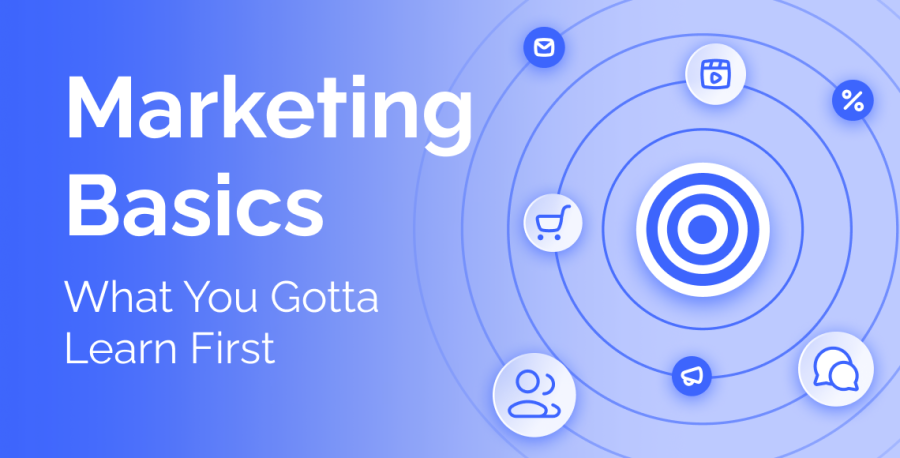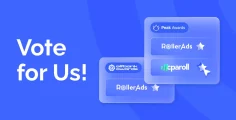They say, “Don’t miss the forest for the trees.” More often than not, people get carried away with details, so they no longer see the bigger picture. Affiliate marketing is no exception, as it is only a piece of the puzzle in the grand scheme of things.
Many affiliates tend to overlook the general principles of marketing and advertising trends, focusing solely on reading about ad networks. And while it’s better than nothing, it’s not enough to spur one’s creativity and start making a decent living.
Digital marketing is all about promoting a product or service, which involves more than acting as a middleman between a product owner and an ad platform. To close deals more consistently, you need to understand the notions of:
- Consumer psychology
- Content creation
- Search Engine Optimization (SEO)
- Website design
- Social Media Marketing (SMM)
…And some other fields, which we will go through in this article. Strap yourself in, as we’re about to deliver a roadmap to make you a better marketer by highlighting things to improve.
Marketing Foundations
Marketing is based on the principle of 4P, a.k.a., “Marketing Mix,” responsible for driving more sales for a company (and your payouts as a marketer as well):
- Product — how a company meets its customers’ needs. It involves decisions related to product design, features, quality, branding, packaging, and the product’s life cycle. As an affiliate marketer, you might want to take extra time to examine what you are going to promote as a customer to ensure you know its Unique Selling Points (USPs). Don’t forget to read some information about the vertical this product belongs to, e.g., sweepstakes, dating, or finances.
- Price — how much money the company charges its customers for the product. Pricing is based on costs (actual value), supply & demand, competition, and perceived value. Take the time to research your GEO of choice, see what kinds of alternatives are sold, and determine if the item has any status impact. Some examples of items with high perceived value are:
- ⌚ Swiss watches
- 🍏 Apple gadgets
- 🚘 German cars
- Place — which marketing channels are leveraged to deliver the product. As an affiliate, this is where your zone of control starts. And while you might be well aware of which social media or websites work better for you, you might also want to know how well the product owner handles logistics to avoid unnecessary refunds and chargebacks, which can hurt your performance.
- Promotion — how the Unique Selling Points (USPs) are communicated to the target audience. This is another branch, which you’re in charge of as a marketer. In your case, it mostly boils down to targeting settings, ad formats, creatives, pre-landers, and overall funnel design.
You should explore the classic marketing strategies, like door-to-door salesmanship, TV or radio broadcasting, guerilla marketing, word of mouth, billboards & posters, brochures & flyers, inbound vs. outbound, B2B vs. B2C, and viral marketing.
Not all of them are useful in your line of work, but they help to spur your creativity and break through the stalemate. They say, “There is nothing new under the sun,” for a reason.
The whole product journey, from the owner to the customer, can be illustrated with the “Business Model Canvas.”
This tool helps break down the complex product flow in any business into nine integral components:
- [Customers] Customer Segments — your ideal target audience, which can belong to 1–2 niches or involve a mass market
- [Customers] Customer Relationships — how you get new customers, influence them to keep on purchasing, and raise their average order value; basically, your interactions with the users
- [Customers] Channels — marketing at its best, how you promote the product at hand
- [Offering] Value Proposition — while you cannot change the USPs of the offer, you can identify it beforehand and decide whether you want to promote it.
- [Infrastructure] Key Activities — what you do to earn a living
- [Infrastructure] Key Resources — what you use to make money
- [Infrastructure] Key Partnerships — who is your ally on your way towards profit (RollerAds, perhaps? 😏)
- [Finances] Revenue Streams — how you earn a living; it’s not limited to being a middleman, as you can monetize your landing pages and become a publisher yourself
- [Finances] Cost Structure — consequences of doing affiliate marketing, or any other business; can be fixed or variable
These are just two tools, but there are more, and most of them are worth exploring. Consider digging deeper into audience and market segmentation, as well as brand positioning.
Speaking of the tools, join RollerAds now to access our Creatives Library, CPA Goal, Smart bidding models, flexible target settings, and many other features — all for free. Get more while spending less time, money, and effort.
The more you know about marketing basics, the easier it is to tailor your approach to your audience’s preferences, optimize the design of your landings, and pitch your message to get your well-deserved conversions.
Content Marketing
Copywriting goes beyond ad copies and CTAs. Genuinely impactful texts rely on a few rules:
- Power comes from the truth
- The idea prevails over its wording
- The simpler, the better
- A well-written text is the one you like to read (or, better yet, re-read) yourself
- Reading out loud pinpoints most of the mistakes
- Examples make reading more accessible, interesting, and relatable
- It’s better to go from simple to complex info
- Useful information should precede everything else
- Heading creates (or ruins) the first impression
- Respect and caring for the user experience (UX) are at the foundation
Content marketing goes beyond the rules of writing and involves distribution strategies, blogging, managing copywriters, and even the basics of SEO. You need to learn how to write texts, which are interesting to read and bot-friendly for them to pop up in search results.
Content is at the core of generating new customers and retaining the old ones. When the text is relatable and resonating, it’s easier to persuade the users and fire a conversion. Thus, you need to pay attention to platform specifics and abridge your texts accordingly.
For instance, LinkedIn favors B2B marketing and dry facts, while Instagram works better with laconic slides and quick descriptions. Explore the most trendy posts here and there to learn the specifics of content creation for any given platform.
Search Engine Optimization
You might have already started noticing that some fields intersect with others, like in the case of content marketing and SEO. We’ve already explored the former; as for the latter, SEO is the foundation for organic traffic, marked by its affordability and quality. To minimize your costs on paid ads, consider learning and doing the following:
- Research keywords with Google Keywords Planner, Ahrefs, SEMrush, Ubersuggest, Moz Keyword Explorer, or Answer the Public to find new word combinations
- Analyze the competitors with tools like Ahrefs, SEMrush, or SpyFu to see which words they rank for
- Pay close attention to Google Search Suggestions, i.e., “People also ask” and “Related searches” sections
On top of researching the keywords, it’s crucial to write all your content within the so-called E-E-A-T framework:
- Expertise
- Experience
- Authoritativeness
- Trustworthiness
Following E-E-A-T in full will help you outpace even the AI, which currently lacks a unique opinion (expertise) and personality (experience).
There are three major sections within the SEO realm:
- On-page optimization — title tags and descriptions, header structuring, alternative text for the images, and inbound linking
- Off-page optimization — backlink building from authoritative websites, social media management, and improving the number of your brand’s mentions elsewhere
- Technical SEO — website speed, mobile optimization, XML sitemap and Robots.txt managing, schema markup, and securing one’s page with HTTPS
Learn how to make trustworthy pages, addressing the users’ pain points for your website to rank higher. Just try to get rid of any duplicate content along the way, as search engine crawlers might get confused this way and delist both pages.
PPC Advertising
Pay Per Click (PPC) is the foundation of affiliate marketing. However, this is one of those niches that is easy to begin with but hard to master. You need to know as much about traffic sources as possible, so that you can cut costs and get only the most relevant traffic for your needs.
The basics start with Google and Facebook Ads, but there are other popular platforms like TikTok and siblings of Facebook: Instagram and WhatsApp. Moreover, there are lots of niche sources, aggregated by ad networks.
RollerAds unites some of the finest but less-known traffic sources. Register now and try out running ads on our platform for some of the highest payouts offered on the market. And with the help of our cutting-edge features, like CPA goal, you can get the most out of your ad placements.
PPC is not only about traffic acquisition but also retargeting. Sometimes your source works just fine, but you need to optimize it properly to make it profitable. Get a statistically significant amount of data and try RollerAds’ in-depth targeting settings to sift through the users and get the most converting ones.
Keep in mind that paid traffic involves tons of subtopics, like whether it’s better to get paid yourself on a CPA or RevShare basis and how the payout model chosen can affect your promotional efforts, including CTAs, copies, and retargeting.
PPC campaigns offer a quicker Return On Investments (ROI), compared to Search Engine Optimization (SEO). They are also relatively easier to set up, rendering them a vital tool for both aspiring and seasoned affiliates. It might be dissatisfying to invest your money at first, but with enough experience, you should be able to minimize your acquisition costs no problem.
Social Media Marketing
Social media are ideal for keeping in touch with your audience and retargeting people who are already aware of your brand. SMM is akin to SEO, making it almost a free source of traffic — of course, you still have to invest your time and efforts, but you will save on monetary costs.
First off, go through some of the mainstream social media platforms:
- Snapchat
- Telegram
- TikTok
- YouTube
Depending on your GEO, you might want to explore some local social media platforms. For example, DACH (🇩🇪, 🇦🇹, 🇨🇭) countries have their own their local version of LinkedIn, which is called XING. Consider asking ChatGPT for locally popular platforms and verify its suggestions.
You might not always have enough time to manage social media and post regularly. Thus, you need to get into influence marketing and learn how to work with them. You need to maintain the delicate balance between letting them keep their tone of voice and giving them a specific enough task, so they actually get the job done.
Analytics and Metrics
When starting affiliate marketing, you might get away with the lack of tracking. However, if you want to spend less on traffic and get more money, you’ll have to learn how to read marketing metrics and establish tracking.
We have already mentioned it in PPC, but analytics serve as a compass in every subniche of affiliate marketing, offering data-driven insights for better decision-making.
Learn how to use Google Analytics and tracking software. Pay close attention to CTR, CR, ROI, Average Order Value (AOV), Customer LifeTime Value (LTV), Bounce Rate, and Rate of Approval — these metrics are fundamental and shed light on how your campaigns perform.
Finally, never neglect A/B tests, as they provide the most trustworthy data on what you should do next when it comes to optimization.
Email Marketing
Email marketing is one of the most efficient marketing channels, boasting relatively low costs and high returns when used correctly. It performs exceptionally well in Tier-1 countries, granting great retargeting opportunities and a higher conversion rate for a reasonable price.
However, it takes more than spamming the letters left and right, especially on Google. To excel in email marketing, you need to learn how to:
- Segment your audience, based on their customer habits
- Create a sequence of letters to gradually convert the user without pushing too much at the moment
- Work with Email Service Providers (ESP), which help to segment your audience better
- Design and write your letters to catch your user’s attention at first sight
- Use email automation tools, so you can write all the emails needed in advance
Emails are a tried and true way of communicating with your audience and letting them know you still mean business.
Web Design
People rarely go online to read — there are libraries for that. They want something more engaging and entertaining, preferably with HQ images. Do you know that 90% of the information transmitted to the brain is visual?
While Artificial Intelligence (AI) can help make creatives, it can’t replace artists yet. Thus, you should at least understand how to use various tools to design creatives, landing pages, and funnels, which convert. Your ads must not come as hard-sells, which is where proper visual elements can save the day.
Affiliate Network Management
As an affiliate, you want to get paid. This is why you need to learn how to:
- Work with various affiliate programs
- Assess their terms and conditions (rates, cookie duration, support responsiveness)
- Create affiliate links
- Understand the dashboard metrics, especially the financial ones
- Split traffic to figure out the best programs
With enough experience dealing with affiliate networks, you’ll begin to understand which programs are for you. It’s not only about the payouts; you’ll learn right away whether you feel comfortable communicating with the managers.
Legislative Aspects of Affiliate Marketing
When it comes to legal compliance, you need to take into account your GEO and vertical. Some regions, like Europe, impose more restrictions on digital ads.
Take, for example, the General Data Protection Regulation (GDPR). It limits how advertisers can store and handle data on users. This can affect your tracking cookies, which collect the info on users by definition. In a nutshell, you need an explicit user’s consent and they can request to view the data you have on them and erase the info if needed.
When working with some verticals, you might need to ensure the user is of the age of consent. So make sure to read the terms and conditions of the advertising network you work with or explore your GEO of choice manually.
Compliance is important to avoid fees and improve the trust of users, as well as partners.
Consumer’s Psychology
People tend to have bounded rationality. They act logically within a certain knowledge span. Once this borderline is crossed, they start to act irrationally. This is where the knowledge of psychology comes in handy.
As a marketer, you want to understand some basic cognitive biases, consumer decision-making, ways to persuade people to make a purchase, and how to counter objections.
Sometimes, it doesn’t matter what you’re selling, but rather how. So if you can pitch your product well and make your customer feel heard, you’ll be surprised at just how much simpler the work with the clients has become.
Marketing Automation
Automating marketing chores is a way to save time and money. Consider implementing Customer Relationship Management (CRM) systems, chatbots, and marketing automation systems, e.g., HubSpot or Marketo.
Precise targeting is at the foundation of lowering your conversion costs. And if you can find and target an optimal audience segment quickly, you’ll be able to launch the campaigns before the competitors do.
Digital Marketing Trends
Finally, you need to monitor the latest trends in the industry to adapt before anybody else does. When it comes to digital advertising, right now there are many trending topics:
- Artificial intelligence and machine learning — for better analytics, faster processing, and behavioral predictions
- Big data analytics, e.g., via Google BigQuery or Tableau — for a better understanding of the converting audience segments
- Video ads and interactive content — for user’s attention and engagement
- Personalization and hypersegmentation — to lower the cost of acquisition
- Programmatic advertising, e.g., RTB and DSP — to know how modern ad auctions on large platforms work
- Micro-influencing — for even greater targeting
- Voice search and ads, e.g., via Google Assistance — for skimming the cream from innovative traffic channels
- Social and ecological responsibility of brands — besides environmental protection, you can actually learn about greenwashing, as well as the ultimate flaws of recycling lithium batteries using pyrolysis and hydrolysis
Conclusion
In the ever-evolving landscape of marketing, affiliate marketing is just one piece of a larger puzzle. To truly excel, you must embrace a holistic approach, integrating key concepts from various marketing domains like content creation, SEO, UX design, and consumer psychology.
By expanding your toolkit and continuously adapting to new trends, you not only enhance your skills but also position yourself as a more effective marketer. Remember, success lies in seeing the bigger picture — because in marketing, as in life, the forest is just as important as the trees.






